Magnetic Separation for Recycling Applications
Whether it’s mixed stream municipal recycling or construction and demolition waste, there are always valuable materials that must be recovered. Magnetic separation lowers the labor cost and time needed for hand sorting. Ferrous metals like iron and steel are easily recovered using overhead magnets, deep draw drum magnets or magnetic head pulleys. For valuable non ferrous metals, such as copper, aluminum and brass, an eddy current separator is the best option. Dings Co. magnetic separation equipment for recycling makes the material recovery process more efficient and increases the purity of your product stream.
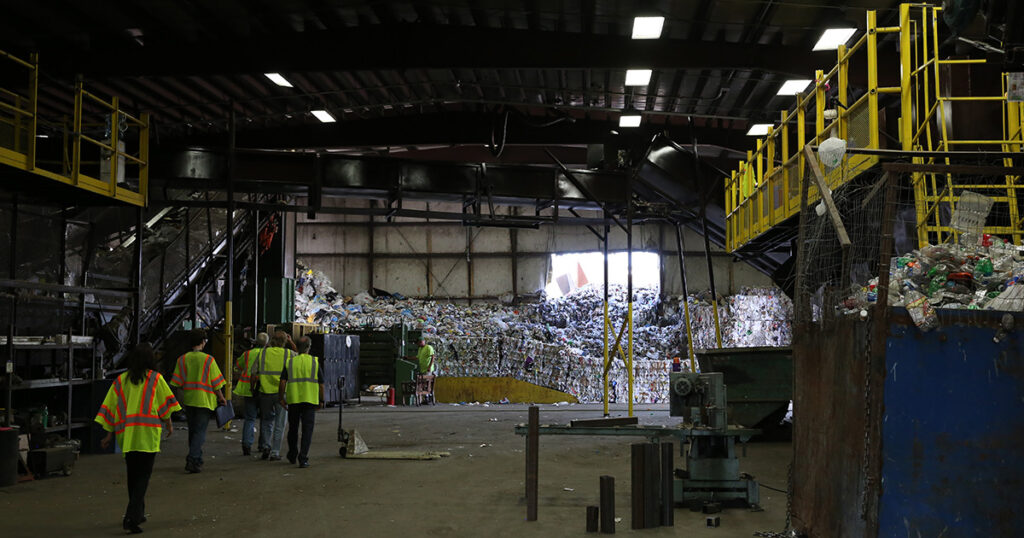
Overhead Magnetic Separators for Recycling
In recycling and material recovery applications where ferrous metal is common, a self-cleaning overhead magnet is often a better option than a stationary model. Self-cleaning magnetic separators come equipped with a multi-ply rubber belt with standard 1-inch vulcanized rubber cleats. This belt travels across the face of the magnet automatically discharging the ferrous metal it pulls from the product stream so it can be easily collected.

Material Recovery Facility (MRF) Overhead Magnetic Separator Design
The MRF (Material Recovery Facilities) self-cleaning magnetic separator features 3-inch tall rubber vulcanized cleats on a tough multi-ply belt. This model has the ability to sweep away large diameter cans that roll over the standard 1-inch cleat, ensuring that they get included in the separation process.
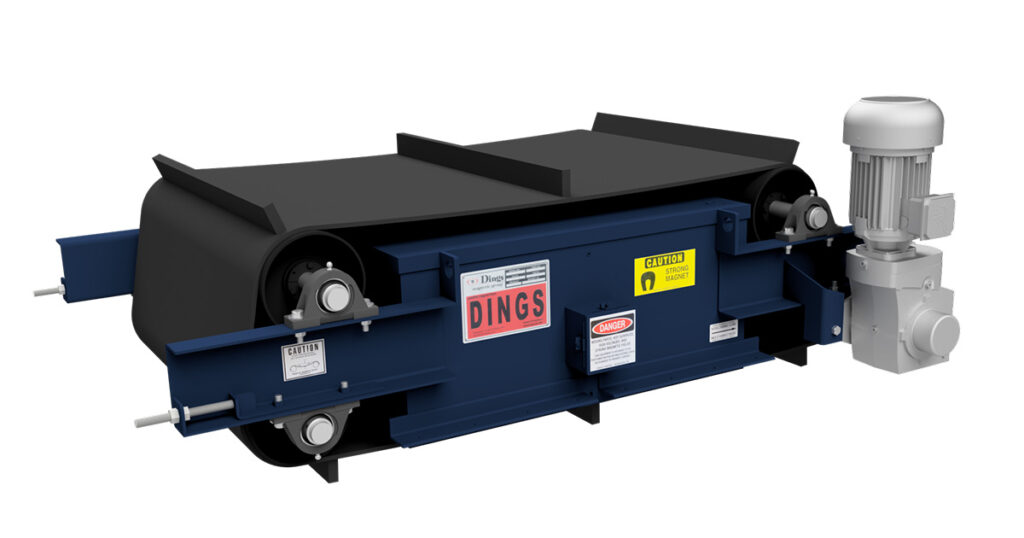
The MRF magnet design is often used in applications such as:
- Commingled recyclables at material recovery facilities to obtain separate material streams.
- Presorted recyclables at intermediate processing facilities (IPFs) for ensuring quality materials.
- Mixed waste processing facilities to recover recyclable ferrous materials.
- Organic materials at composting locations.
- Shredded tires at tire recycling processing sites.
Severe Duty Overhead Magnetic Separator Design

The severe duty overhead electromagnet is specifically designed to withstand the harshest environments and toughest material recovery applications like concrete recycling and construction and demolition waste. The Severe Duty Model comes equipped with a Dings ‘Durabelt’ of stainless-steel pads and cleats. The Durabelt Prevents the underlying rubber belt from being pierced by sharp ferrous metal like rebar. Included with the severe duty overhead magnet design are a heavy-duty drive assembly, lagging on the drive pulley and reinforced suspension/mounting hardware.
Eddy Current Separators for Recycling
The key component of the eddy current separator is the magnetic rotor, which has a series of permanent rare earth magnets mounted on a support plate attached to a shaft. The magnetic rotor is surrounded by a wear shell which supports the conveyor belt. This allows the rotor to spin independently and at a much higher speed than the wear shell and belt around it.
When a piece of non-ferrous metal (such as aluminum) passes over the separator, the magnets inside the rotor rotate past the aluminum at high speed. This forms eddy currents in the aluminum which, in turn, creates a magnetic field around the piece of aluminum. The polarity of that magnetic field is the same as the rotating magnet, causing the aluminum to be repelled away from the magnet. This repulsion makes the trajectory of the aluminum greater than that of the nonmetallic material, allowing the two material streams to be separated for recycling or material recovery.
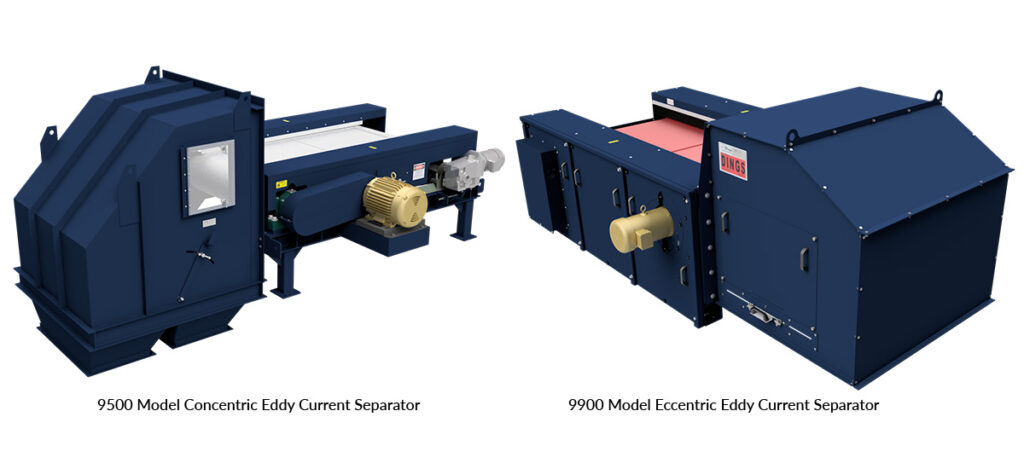
Concentric Eddy Current Separators
Depth of magnetic field is relative to the size of magnets inside the rotor. For example, the Dings 9500 concentric eddy current separator has a larger/deeper field and is ideal for recycling applications with larger sized non-ferrous in a higher through put. While the 9100 eddy current separator is better for recovering fractional non-ferrous metal up to the size of aluminum cans. The Dings concentric design has a triple layered shell consisting of an outer layer of ceramic tile and fiberglass around a heavy-duty stainless steel inner shell to protect the magnetic rotor assembly. This design lowers maintenance and replacement costs.

Eccentric Eddy Current Separators
The 9900 eccentric eddy current separators’ magnetic field is the same as the 9100 concentric version and is ideal for the same types of recycling applications. However, it’s off center “eccentric” magnet design of the rotor allows ferrous metal that made it past the upstream magnetic separator to be released from the belt as it leaves the magnetic area of the outer rotor shell. This reduces the likelihood that ferrous metal will cling to and damage the belt and shell, extending rotor life.

Deep Draw Drum Magnetic Separators
/) are specially designed for heavy duty, high-volume ferrous recovery. This large and powerful magnetic drum has a nonmagnetic outer shell that is driven around a fixed magnet. Ferrous metal is magnetically drawn out of the material feed, held against the rotating shell, and then released at the discharge point. The Dings Deep Draw Drum magnetic separator has the rugged construction needed for separating ferrous metal from the material stream in shredded cars, scrap metals, municipal solid waste, and other recycling applications. The Deep Draw Drum can be fed at multiple positions since the internal magnet assembly is adjustable. The Dings Deep Draw Drum’s permanent magnet design outperforms electric-powered models in a number of important ways, it always operates at top efficiency and maintains a constant magnetic strength throughout the day.

Magnetic Head Pulley Separators
Dings Magnetic Head Pulleys are non-electric, self-cleaning magnetic separators. They operate as head pulleys on conveyors to separate ferrous metals from materials conveyed in bulk form. They are designed for machinery protection and product purification. Our magnetic head pulley’s magnetism is produced by an internal ceramic magnet assembly that is enclosed with a nonmagnetic stainless steel shell.
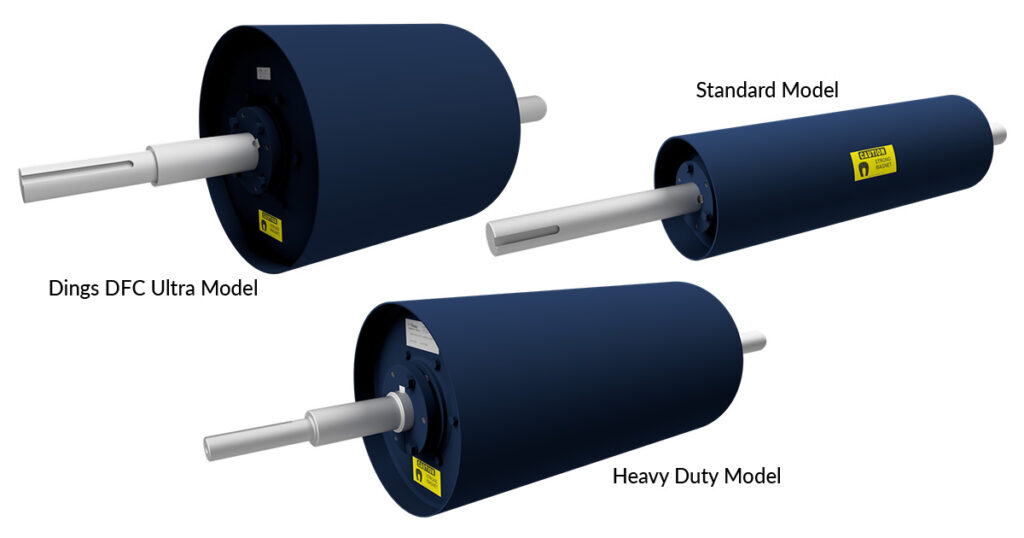
Since every recycling application has its own specific needs regarding the magnetic depth of field required, Dings Company Magnetic Group is the only company to offer magnetic head pulleys in three different magnetic strengths. The series in order of magnetic strength are standard, heavy duty and our strongest, Dings DFC Ultra. Dings magnetic head pulleys also offer various types of vulcanized lagging.
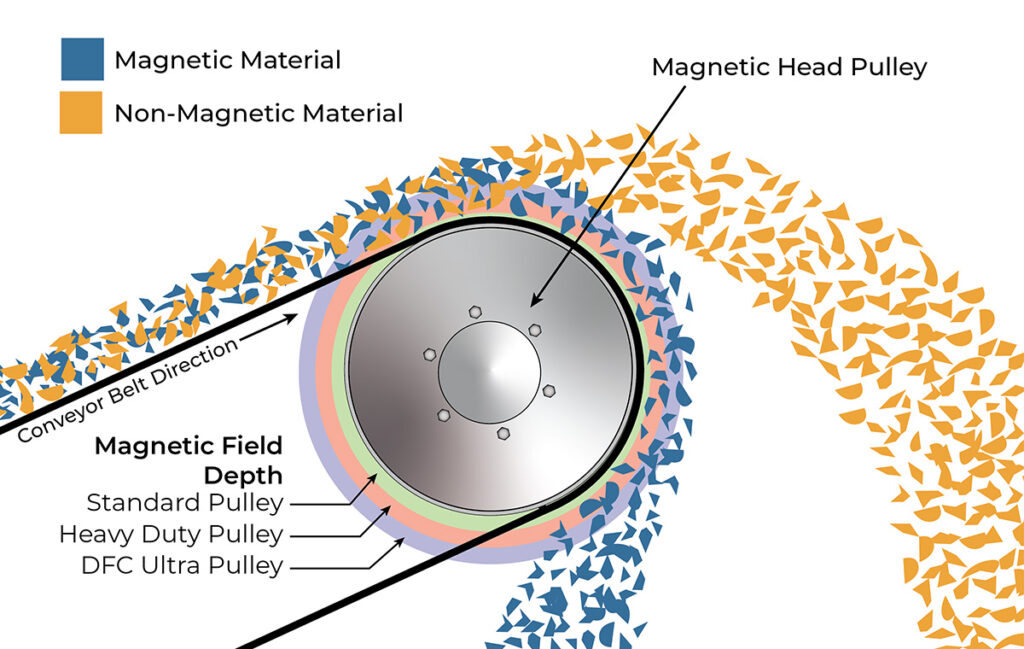
Dings Company Magnetic Group Helps You Find The Right Magnetic Separation Solution for Your Recycling Application
Dings Company Magnetic Group engineering and sales staff work together from our Milwaukee, WI factory to provide outstanding customer service from experts in magnetic separation. We listen to our customers to gain an understanding of their needs and apply our experience in their trade to provide magnetic separation equipment that is sized and positioned for the best possible performance in their specific application. Contact us at magsales@dingsco.com or call us at (414)672-7830 for help finding the right magnetic separation solution for your recycling application.
